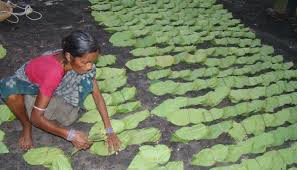Jharsuguda: Kendu leaf business in Jharsuguda district stares at an imminent closure as climate change and rapid industrialisation have resulted in a sharp decline in collection of the important minor forest produce in this western Odisha district.
30 years back, the district was in great demand in terms of collection of kendu leaf but climate change and rapid industrialisation have impacted its production to the extent that the once-profitable business may shut down completely in coming days.
According to available data, 11,800.80 quintal of kendu leaves were produced under Jharsuguda kendu leaf division in 2017, 8,380.80 quintal in 2018, 5,988.60 quintal in 2019, 5,082.60 quintal in 2020 and 8,059.20 quintal in 2021. A target of 10,000 quintal was set for production in 2022 and 2023. However, the collection is stated to be only 8,632.80 quintal in 2022 and 5,204 quintal in 2023.
Unseasonal rainfall, hailstorm, cloudy weather, industrialisation, environmental pollution and mindless tree felling are behind the sharp decline in kendu leaf production. It is apprehended that kendu leaf production might further decline in the district if the situation persists.
While the collection in other parts of western Odisha like Bolangir, Titilagarh, Padampur, and Rourkela is booming, it shows a steady decline in Jharsuguda district.
Role of seasonal workers, munsis, chaurasi checkers, binding checkers, circle checkers and head checkers is important in kendu leaf trade.
Reports said six kendu leaf range offices function under the Jharsuguda kendu leaf division office. These offices are at Jharsuguda, Belpahar, Kadamdihi, Kanika, Duduka and Gopalpur in the district.
Kendu leaf trade was taken up departmentally with effect from January 1973 when Nandini Satpathy was the Chief Minister of Odisha.
There are 19 kendu leaf divisions in the state including at Jharsuguda. Over thousands of kendu leaf pluckers and hundreds of seasonal workers are engaged in the business under Jharsuguda division as they eke out a living out of it.
However, the decline in kendu leaf production here has sparked concern. Every year thousands of men and women go into the forests with the hope of earning some bucks by collecting kendu leaves. The kendu leaf season starts in March, bush cutting in April, repairing of the kendu leaf depots in May, while plucking of leaves starts from June, the binding of kendu leaf for manufacturing bidis continues till October.
The seasonal workers are employed during the kendu leaf season and the entire process is supervised by kendu leaf rangers, deputy rangers, foresters and forest guards. The Jharsuguda kendu leaf division has 303 depots and gone are those days when the demand for kendu leaf was very high in Jharsuguda district.
Collection has declined to a great extent in Jharsuguda district after lakhs of trees were chopped off in 2000 to make way for establishment of industrial plants.
Lack of a favourable atmosphere is attributed as the main reason behind the decline in availability. As a result, thousands of men and women have been deprived of employment.
Bush cutting has started from February 20 this year but it is feared that the production may reduce further due to unseasonal rainfall plaguing the district.
Moreover, villagers engaged in collection of Mohua flowers are setting fire to the forest. It is also alleged that kendu leaf is being smuggled in frequent basis from the Bagdihi railway station affecting its production. The seizure of kendu leaf by the Forest officials from Bagdihi railway station three months back is a case at this point.
The state government pays bonus to the kendu leaf pluckers and seasonal workers from the profit it earns from the trade.
PNN






































